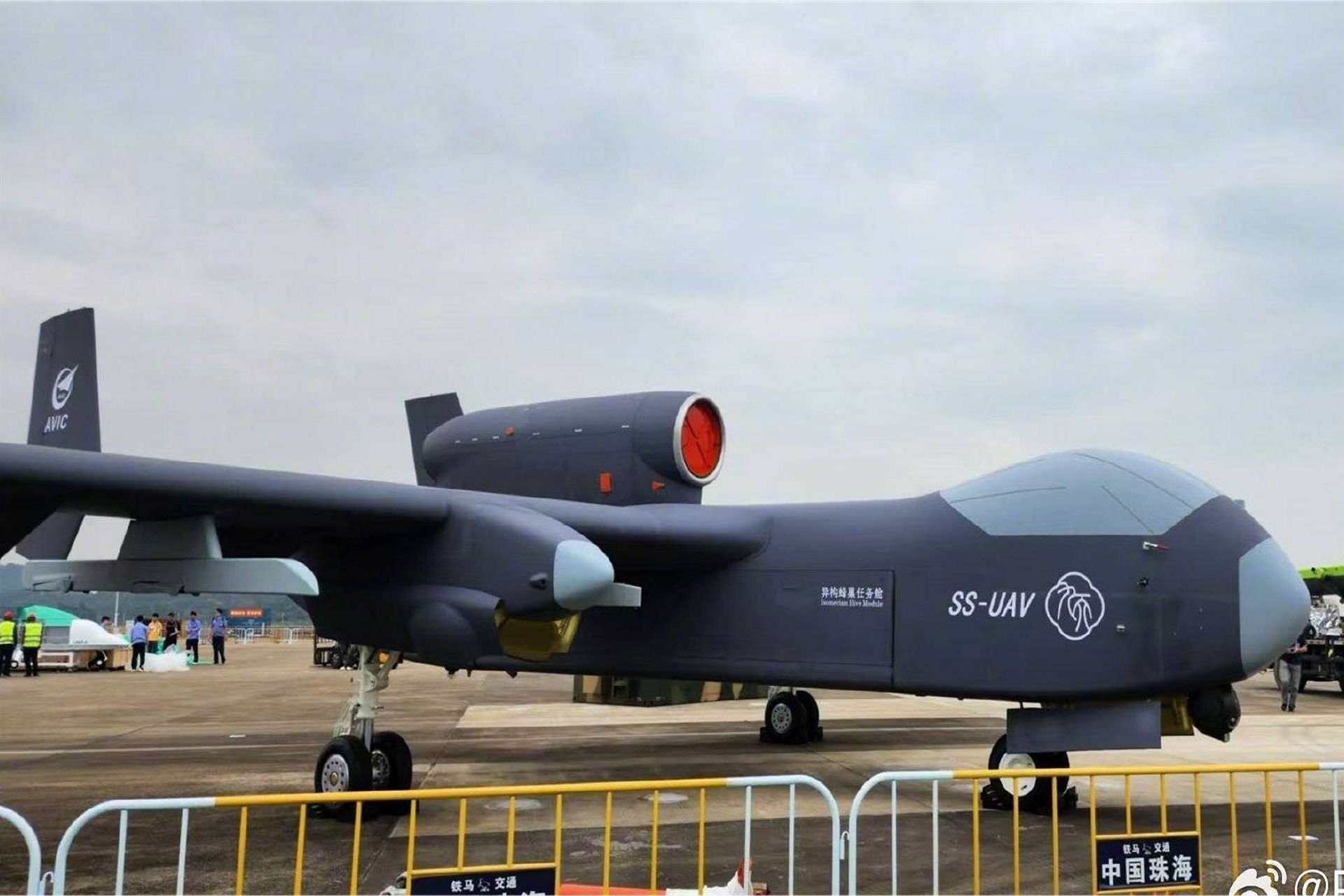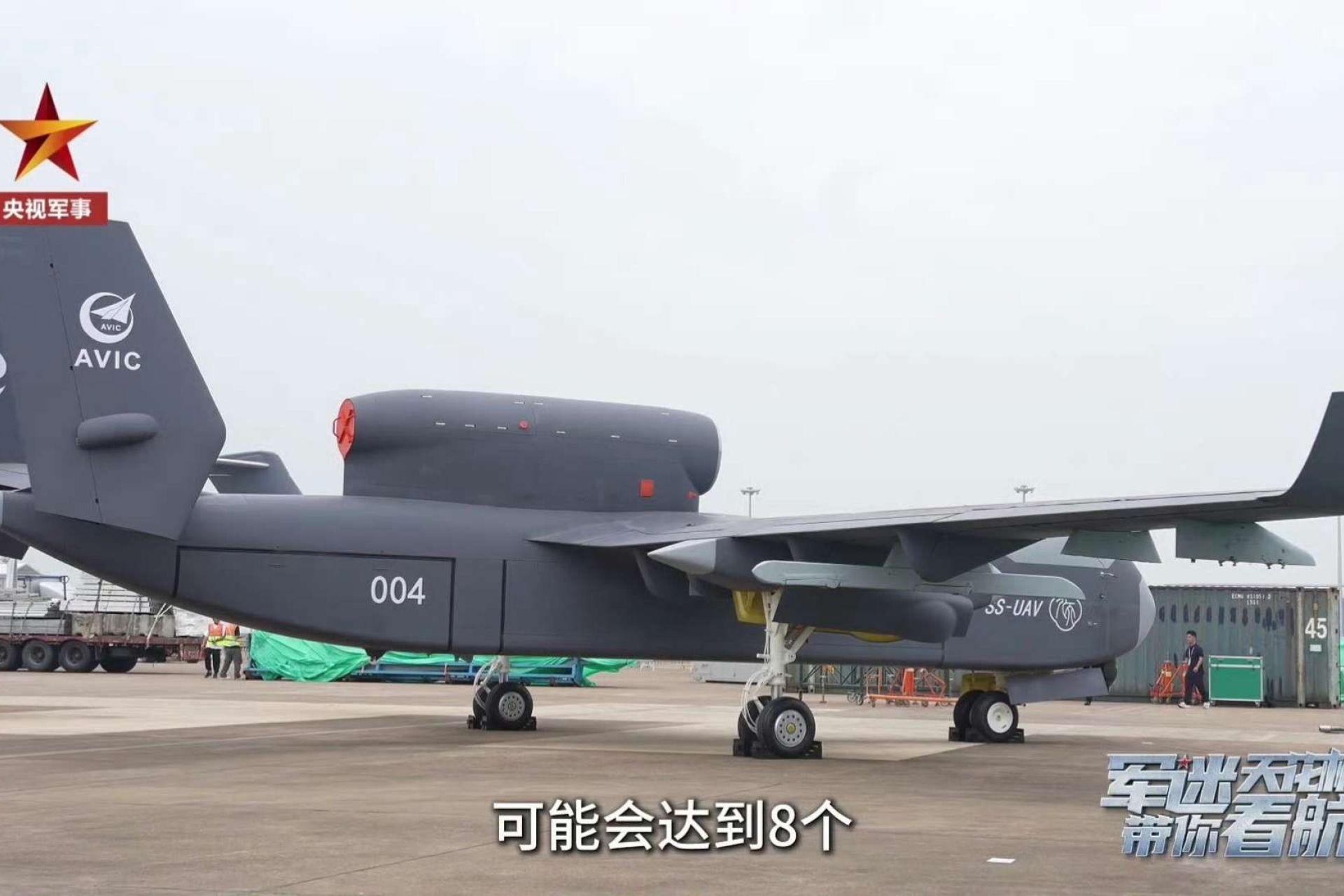Breaking News
China Designs Fifth-Gen Jiutian Strike Drone to Rival US RQ-4 and MQ-9 UAVs.
At the Zhuhai Airshow, scheduled for November 12-17, 2024, China plans to reveal its latest development in military drone technology: AVIC's 10-ton SS-UAV, known as "Jiutian." This large UAV, designed for reconnaissance and strike missions, is positioned as a potential competitor to prominent U.S. drones like the RQ-4 Global Hawk and MQ-9 Reaper, indicating China’s progress in advancing UAV capabilities for strategic operations. The "Jiutian" marks a notable development in China’s military aviation, underlining its focus on expanding its drone technology for a range of operational roles.

China Fifth-Gen Jiutian Strike Drone (Picture source: China Social Network)
In the days leading up to its official unveiling in Zhuhai, early-release photos of the "Jiutian" have surfaced, showcasing its robust design and advanced configuration. These images reveal a large, single-engine drone with a rear-thrust engine, featuring a modular and high-payload capacity—a milestone for the Chinese military in the high-endurance drone competition.
The SS-UAV, developed by the Aviation Industry Corporation of China (AVIC), features an imposing single-engine structure, a wide wingspan, and a fuselage equipped with eight underwing pylons, enabling it to carry a variety of payloads, including surveillance sensors and potentially weapons. Comparable in size to the B-25 or H-5, the "Jiutian" incorporates a modular mission bay in the center of its fuselage, ensuring greater operational flexibility and facilitating reconfiguration for specific reconnaissance or strike missions.
One of the most impressive aspects of the "Jiutian" UAV is its "heterogeneous honeycomb mission bay," an innovative module capable of deploying numerous smaller drones in the air. This capability makes it particularly suitable for saturation or disruption operations, enabling extended surveillance and targeted strikes autonomously. This unique mission module, a first in the field of large drones, shows that the "Jiutian" was designed not only for surveillance missions but also for swarm attacks, enhancing its versatility and effectiveness on the battlefield.
In future scenarios envisioned by China, the SS-UAV "Jiutian" would play a decisive role following air superiority achieved by fifth-generation aircraft and ballistic missiles over a strategic area, such as a contested island. The "Jiutian," along with other large drones and long-range cruise missiles, would then be deployed to maintain constant pressure and ensure air dominance. This strategy would enable China to project a persistent aerial presence, deterring any enemy offensive and providing reconnaissance and immediate strikes as soon as a target is identified.
The SS-UAV’s impressive size and single engine allow it to reach high altitudes, as suggested by its nickname "Jiutian," meaning "high altitude." This elevated altitude not only gives it an extended range for long-duration missions but also enhances its discretion, making it harder to detect by ground-based radar systems. Its rear-mounted engine configuration reduces its thermal signature, adding a layer of stealth essential for prolonged reconnaissance missions in potentially contested areas.
The SS-UAV "Jiutian" is more than a simple addition to China’s UAV arsenal; it embodies China’s ambition to compete with the most advanced American drones and to develop systems capable of fulfilling multiple roles, from surveillance to direct strikes. With a unique combination of payload options, stealth capabilities, and a honeycomb modular mission bay for swarm attacks, the "Jiutian" demonstrates China’s strategic vision for aerial dominance through unmanned systems.
The SS-UAV "Jiutian" presents capabilities that position it as a direct competitor to the RQ-4 Global Hawk and the MQ-9 Reaper, combining some of the characteristics of both American drones while introducing unique innovations. Like the RQ-4, the "Jiutian" is designed for high-altitude, long-endurance missions, with a wide wingspan and extended flight capacity suitable for persistent surveillance over vast geographical areas. Its rear-mounted engine, similar in principle to that of the RQ-4, reduces its thermal signature, optimizing its stealth at high altitudes. In contrast, the "Jiutian" also adopts tactical elements of the MQ-9 Reaper, notably its eight underwing pylons, allowing it to carry varied payloads, from surveillance sensors to potential armaments for tactical strikes. Moreover, its honeycomb modular mission bay, capable of deploying smaller drones, grants the "Jiutian" a unique and versatile capacity for saturation missions and swarm strikes—a feature absent in both the RQ-4 and MQ-9.
The development of reconnaissance and strike drones like the "Jiutian" aligns with China’s strategy to catch up with and compete against American military capabilities. Since the early 2000s, China has invested heavily in UAV technology research and development, launching programs like the Wing Loong and Caihong series, which gradually built a reputation in the international market. In the early 2010s, the People's Liberation Army ramped up efforts to produce high-endurance drones, inspired by the performance of American RQ-4 and MQ-9 drones, to meet its needs for long-term surveillance and targeted strikes. In 2017, the rapid advancement of the Wing Loong II series showcased China’s effectiveness in multi-role drone technology. The launch of the SS-UAV "Jiutian" in 2024 at the Zhuhai Airshow marks a culmination of this progression, with a model combining high-altitude capabilities and modular strike functions, the result of decades of strategic development to rival the best of American UAV technology.
Chinese drones have proven their effectiveness in various operational contexts, supported by practical feedback from user countries, beyond Beijing’s official statements. For example, Wing Loong drones have been used by nations like the United Arab Emirates, Egypt, and Saudi Arabia, particularly in the Middle East and North Africa, for reconnaissance and strike missions, where their performance has been deemed satisfactory. The armed forces of these countries have reported the reliability of the Wing Loong drones in active conflict environments. Similarly, drones from the Caihong (CH) series have been acquired and deployed by Algeria, Iraq, and Pakistan for surveillance and combat operations, demonstrating their capacity to support diverse missions. These field reports confirm that the effectiveness of Chinese drones relies not only on official claims but also on practical assessments from users, reinforcing their reputation in the international market.
Regarding the "Jiutian" (SS-UAV), it is still too recent to have user feedback from international clients or even the Chinese military. Introduced for the first time at the 2024 Zhuhai Airshow, the "Jiutian" is perceived as a significant technological advancement, though its actual performance has yet to be proven in operational contexts. Available information relies mainly on official announcements from China’s defense industry, highlighting its high-altitude capabilities, extended endurance, and modular strike capacity. China claims that the "Jiutian" combines elements from both the RQ-4 Global Hawk and MQ-9 Reaper, but in the absence of confirmed deployments or feedback from third-party users, its actual capacities remain to be validated on the field to establish its true effectiveness.

China Fifth-Gen Jiutian Strike Drone (Picture source: China Social Network)


























